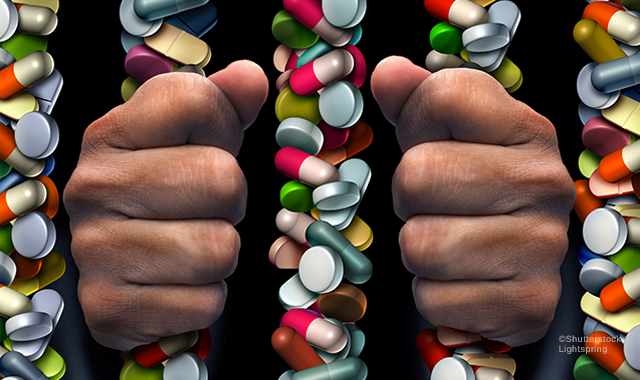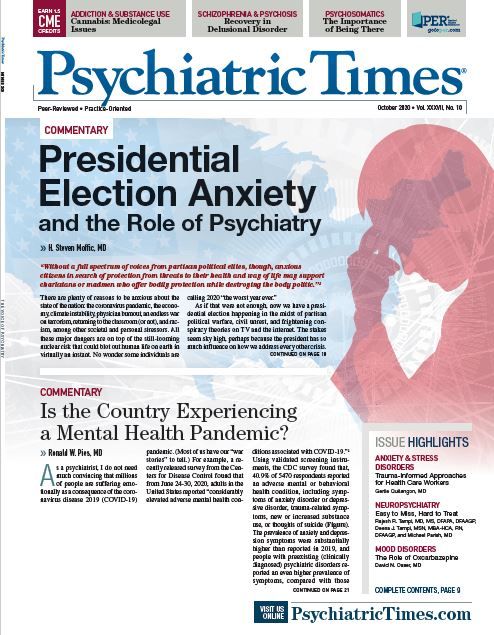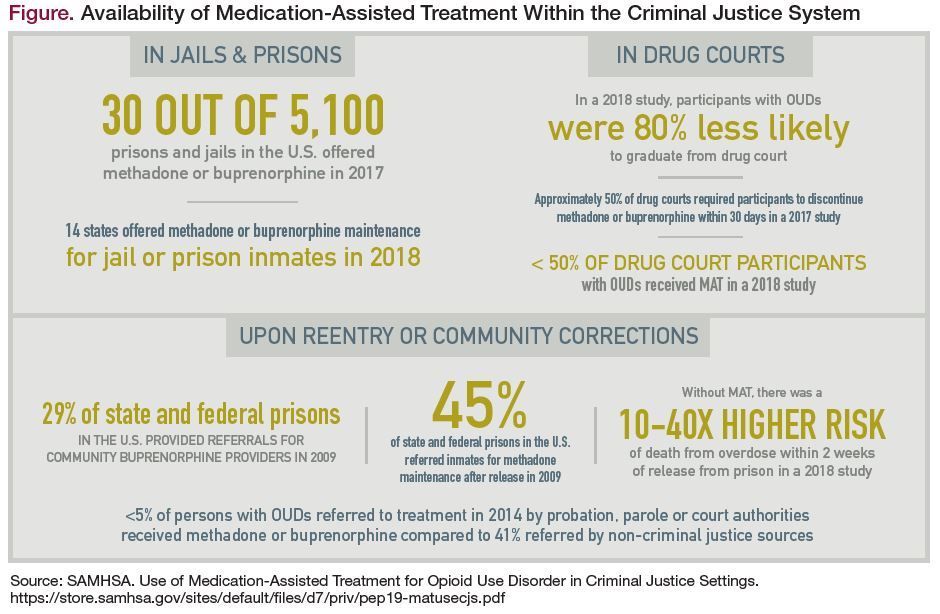The underlying pharmacology of drugs used in MAT and their physiological effects on individuals are well understood. MAT is known to assist in diminishing cravings, and some agents can alleviate the withdrawal symptoms associated with OUD.
Publication
Article
Psychiatric Times
The Case for Medication-Assisted Treatment: An Ethical Priority
A significant proportion of incarcerated individuals struggle with with addiction. So what is being done about it?
Lightspring/Shutterstock

SUBSTANCE USE DISORDERS
Substance use disorder (SUD), including opioid use disorder (OUD), affects a significant proportion of the American population—20.3 million (7.4%) of Americans aged 12 years or older had a SUD in the past year.1 Of these, 2 million people had an OUD from heroin and/or misuse of prescription pain relievers.Although medication-assisted treatment (MAT) with methadone, buprenorphine, or naltrexone for OUD is the most efficacious, evidenced-based treatment that is recommended by the National Institute of Health, Substance Abuse and Mental Health Services Administration (SAMHSA), and the World Health Organization, only 11% of patients with an OUD are prescribed approved treatment.
Limited access to MAT has been cited as a substantial barrier for patients with OUD; inequities across ethnic and sociodemographic groups speak to the health disparities evident in society. The provision of appropriate treatment and lack thereof are even more troublesome when considering the vulnerable populations that bear the disproportionate burden of SUDs and OUDs—namely, those involved with the corrections system and those with serious mental illness (SMI). It is no secret that a significant proportion of the criminal justice population has an SUD.1,2
Justice in criminal justice
Between 62% and 86% of individuals arrested test positive for recent drug use,3 and 64% to 76% of arrestees meet diagnostic criteria for SUD. More than half of individuals with a prescription OUD or heroin use in the past year report contact with the criminal justice system.2 Similarly, in terms of mental illness, 9.2 million Americans over 18 years old, or 3.7% of American adults, had co-occurring SUD and any mental illness in 2018.1
In line with the goal of reducing recidivism, a proportion of the criminal justice population is often diverted to drug courts. According to SAMHSA, there are currently 2700 operational drug courts in the United States.1 These courts adjudicate cases involving substance-involved offenders, or individuals who were arrested for a drug-related offense and/or are eligible to enter a drug court program. Typically, an offender is followed by a drug court for 12 to 18 months. The National Drug Court Institute reports that more than 116,000 criminal offenders were served by a drug court program in 2009.4 However, only 56% of drug courts offer MAT to participants.5 Additionally, most individuals with SUD do not receive treatment while they are incarcerated, or they are forced to withdraw from treatment they were receiving before incarceration (Figure).2
Ethical considerations around MAT in caring for these patients are apparent through lenses of health care as a source of harm, paternalism, and violation of rights; through a refusal to provide access to appropriate care; or through the intersection of medicine and epidemiology. These considerations include issues around access to MAT and the context in which consent to MAT is obtained from those to whom it is offered.
MAT is an approved treatment for OUD by the US Food and Drug Administration. The underlying pharmacology of drugs used in MAT and their physiological effects on individuals are well understood. MAT is known to assist in diminishing cravings, and some agents can alleviate the withdrawal symptoms associated with OUD. However, many drug courts and prison facilities do not afford provisions for MAT for incarcerated individuals.2,5
In the absence of MAT, individuals with OUD are forced to undergo detoxification with full exposure to the negative physiological and psychological withdrawal symptoms that they could easily avoid with MAT, including nausea, vomiting, diarrhea, agitation, anxiety, and suicidality.3 This lack of access to approved and indicated therapy for a disease process could be construed as a punitive measure and borderline cruel and unusual punishment. In fact, detoxification in the absence of MAT is less efficacious than MAT and harmful to human health.4
Surveys of drug courts and the US prison systems do find practical reasons for not providing MAT, namely, the cost and lack of access to local providers. However, there are courts that do not permit MAT because of a lack of knowledge and stigma around OUD. Many drug court teams are uncertain about the underlying physiological mechanisms of opioid receptor agonists used in MAT and their efficacy in treating OUD. Some report they believe that patients with OUD use MAT to get high and not for treatment of OUD.4 Further, others think that MAT use for OUD is essentially replacing one addictive substance with another.4
The false narrative that MAT reinforces addiction or replaces an illicit substance (heroin) has a negative impact on individuals.3 Additionally, the intersection of medicine and epidemiology is evident when those with SUDs/OUDs who do not have access to MAT turn to unsafe practices, such as the use of unclean needles to inject impure heroin or heroin laced with synthetic fentanyl. This, in turn, leads to increased morbidity and mortality as well as to public health issues of increased transmission of infectious diseases.3
The dangers of coercion
The other side of the coin: being processed by a drug court and given the option of either incarceration or MAT. Asking an individual with a mentally incapacitating illness to consent to treatment brings in to question autonomy and validity of consent. Informed consent, by definition, should be voluntary and free of coercion.6,7 It should be obtained from someone with the capacity to make a decision after they have an understanding of the risks and benefits of available options. Consent under the threat of incarceration, or while incapacitated, is not informed consent and compromises individual autonomy.6,7
Many individuals with OUDs/SUDs choose Narcotics Anonymous, peer support, drug-free toxification, or treatment modalities other than MAT.3 Assuming a binary disposition, MAT versus drug-free detoxification is overly punitive and a violation of voluntariness and self-determination of these individuals.
Patients with SUDs/OUDs often contend with unfavorable correctional system interactions as well as SMI, and they predominantly comprise minorities from low-income or limited educational backgrounds and with reduced social support. They are a vulnerable population whom society has largely marginalized.2 Their rights are threatened, and they are afforded subpar and borderline unethical care. The underlying reasons behind this unsettling phenomenon is a lack of health literacy around MAT and stigma associated with OUD in nonclinical settings.
Concluding thoughts
An ethical framework is needed, as well as best practice guidelines highlighting the efficacy of and science behind MAT specifically directed at the correctional system. Addressing limitations in knowledge base and highlighting shortcomings in protecting the rights of incarcerated individuals are both essential, in partnership with all stakeholders (including incarcerated patients, rights groups, judges, the correctional system, and medical bodies).
Mr Kaleka is a fourth-year medical student at Central Michigan University College of Medicine, Saginaw, MI. Dr Perzhinsky is associate professor of medicine atCentral Michigan University College of Medicine.
References
1. Key Substance Use and Mental Health Indicators in the United States: Results From the 2018 National Survey on Drug Use and Health. (HHS Publication No. PEP19‑5068, NSDUH Series H‑54). Rockville, MD: Center for Behavioral Health Statistics and Quality, Substance Abuse and Mental Health Services Administration. 2019. Accessed September 10, 2020. https://store.samhsa.gov/product/key-substance-use-and-mental-health-indicators-in-the-united-states-results-from-the-2018-national-survey-on-Drug-Use-and-Health/PEP19-5068
2. Winkelman TN, Chang VW, Binswanger IA. Health, Polysubstance Use, and Criminal Justice Involvement Among Adults With Varying Levels of Opioid Use. JAMA Network Open. 2018;1(3).
3. Ludwig AS, Peters RH. Medication-assisted treatment for opioid use disorders in correctional settings: An ethics review. Int J Drug Policy. 2014;25(6):1041-1046.
4. Matusow H, Dickman SL, Rich JD et al. Medication assisted treatment in US drug courts: Results from a nationwide survey of availability, barriers and attitudes. J Subst Abuse Treat. 2013;44(5):473–480.
5. Substance Abuse and Mental Health Services Administration. Adult Drug Courts and Medication-Assisted Treatment for Opioid Dependence. In Brief. 2014;8(1). Accessed September 10, 2020. https://store.samhsa.gov/product/Adult-Drug-Courts-and-Medication-Assisted-Treatment-for-Opioid-Dependence/sma14-4852
6. D’Hotman D, Pugh, J, Douglas T. When is coercive methadone therapy justified? Bioethics. 2018;32(7):405–413.
7. Beauchamp TL, Childress JF. Principles of Biomedical Ethics. New York: Oxford University Press; 2019.
This article was originally published on August 17, 2020, and has since been updated. -Ed








